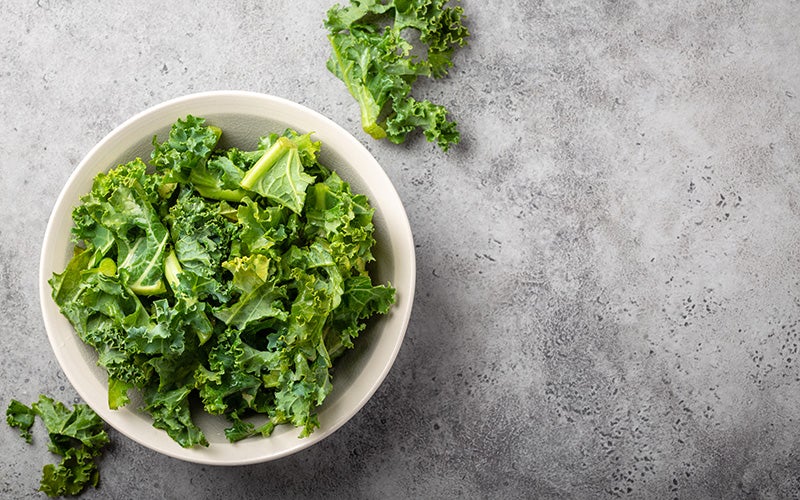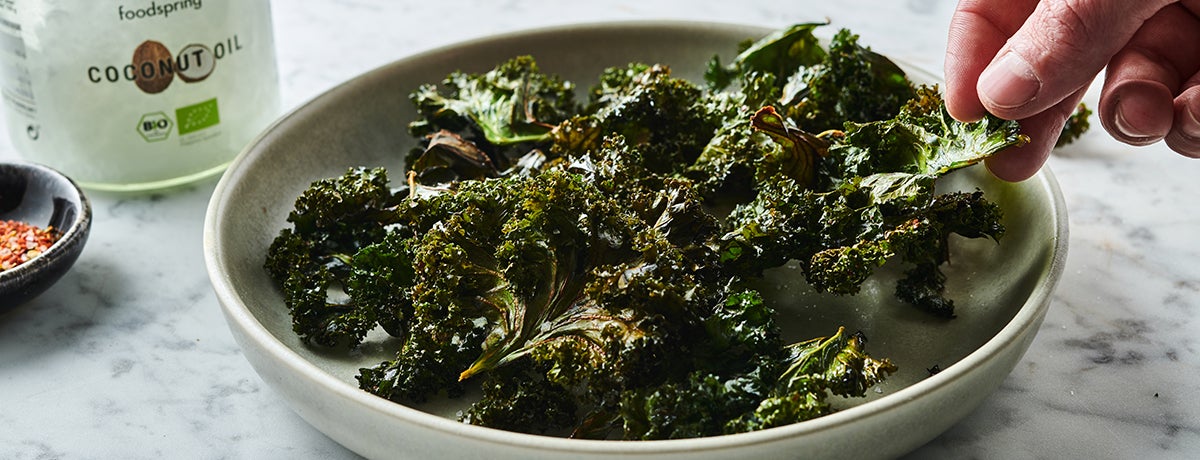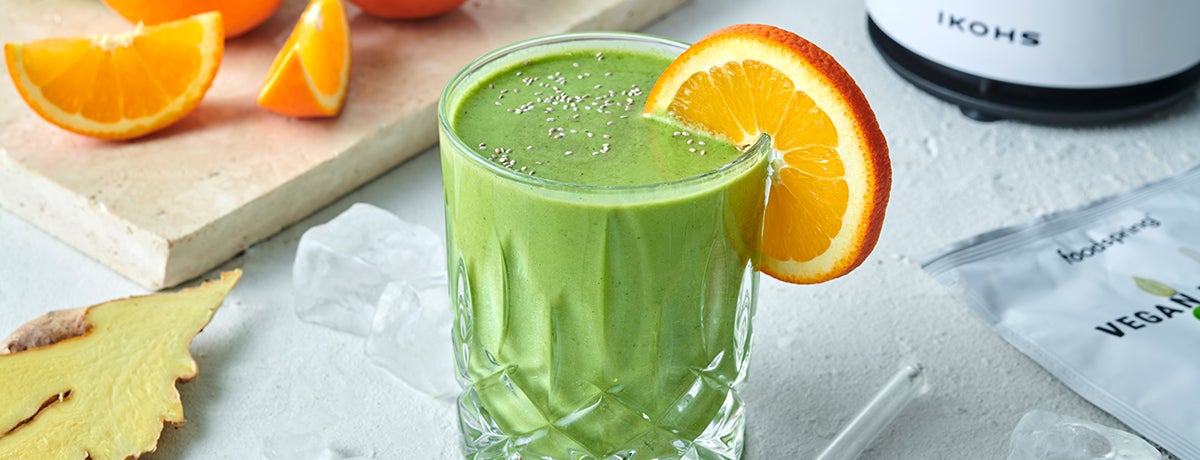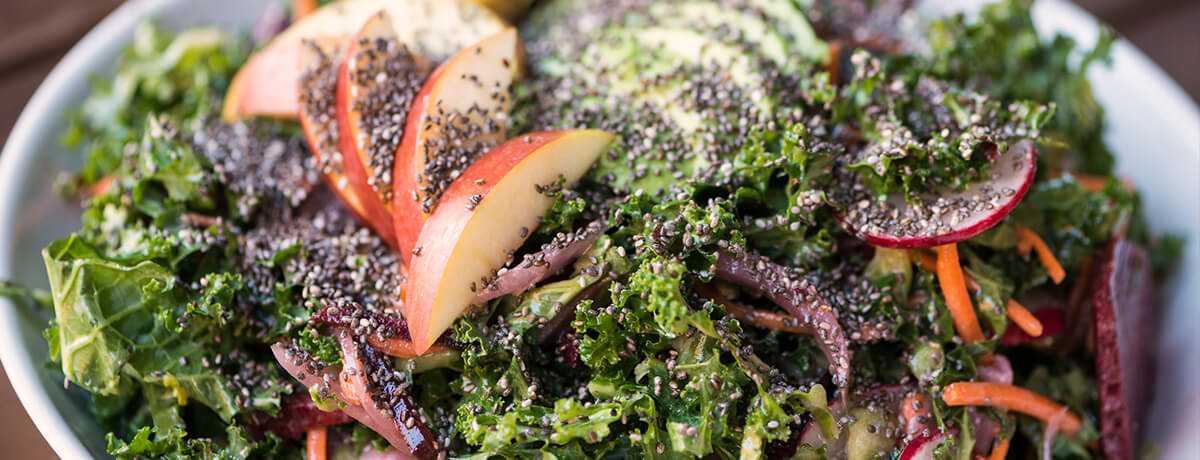Health Benefits of Kale
 ©foodspring
©foodspring
It’s high in protein, alkaline, and full of vitamins and essential minerals: no wonder everyone says kale is a superfood! These curly cabbage leaves have a relatively mild taste and keep you fuller longer, and they’re also low in calories, so they’re the perfect side dish for healthy meals. Check out some of the benefits of kale, how it’s prepared, and our favorite kale recipes!
Is Kale a Kind of Cabbage?
Kale, also known as curly kale, is one of the cruciferous vegetables that typically show up in markets in the fall and winter. It’s easy to tell it apart from other cabbages because kale has distinctive curly leaves and no central head. Some varieties have light or dark green leaves, others have purple or black. Fresh from the field, they can end up with plenty of dirt, which makes preparing kale a bit more time-consuming. If you’re in a hurry, frozen kale is a great alternative.
Although kale is typical for northern Europe, this popular cruciferous vegetable is eaten all over the world. Kale tastes spicy and tart with a slightly nutty-sweet note. Traditionally, it’s prepared with clarified butter and bacon and served with sausages or smoked pork. But of course it can also be more healthy: several years ago kale started to shift into more modern uses and its served in green smoothies, salads, or as crispy kale chips.
Is Raw Kale a Superfood?
Superfoods are usually defined as foods with a particularly high nutrient density. These usually include imported fruits and veggies with certain health benefits such as goji berries, chia seeds, and matcha. But there are also foods grown closer to home that are packed full of nutrients, and one of them is kale.
The nutritional profile of raw kale outpaces most other leafy greens, and kale is number one even among cabbages. In general, winter vegetables contain an above-average amount of protein and iron, are high in calcium, and are good sources of plenty of vitamins. Another one of the health benefits of kale? It’s alkaline, which can help your digestion!
Tip: Here’s our guide to amazing fruits and vegetables in season
Origin and Season
Kale originally comes from the eastern Mediterranean, but as it’s become popular around the world, it’s now grown in many regions. Areas of kale production now range from Central and Western Europe to North America and East and West Africa. The ground needs to stay cool for a longer period of time so that the kale can develop its tart, sweet aroma. The lower the temperatures around the harvest, the sweeter the leaves taste, because the cold causes the plant to produce more sugar. Mild weather, on the other hand, gives kale a bitter taste.
Fresh kale is available between late September and February. The earliest harvest usually takes place after the first ground frost. If you don’t want to go without this superfood in the other months, look for products in a freezer or in a jar. But, of course, local produce still tastes best when it’s fresh and organically grown.
Kale Nutrition Facts
In terms of ingredients and nutritional values, kale is number one among cabbages: it has three times as much protein and four times as much iron as white cabbage. At the same time, winter vegetables are a great source of calcium in general. There is roughly as much calcium in 100 grams as in 200 milliliters of milk. When it comes to getting more vitamin C in your diet, kale is also on top. Just 100 grams has the recommended daily amount of vitamin C for adults. In addition, the cabbage is rich in vitamins E and A as well as healthy phytochemicals that may help fight free radicals.
On top of all that, kale is a great source of fiber. Eating kale can help keep you fuller longer and has a positive effect on your digestion. This leafy green is also 85 percent water, contains only a few calories and hardly any fat. You can’t get any healthier, right?
100 grams of kale contain:
| Calories | 37 |
| Protein | 4.2g |
| Fat | 0.9g |
| Carbs | 2.5g |
| Fiber | 4.2g |
Looking for other members of the cabbage family? Read more about Brussels sprouts here!
Care and Keeping of Kale
Here are our tips for buying, storing, and preparing kale:
#1 Buy
Keep these few points in mind when shopping for kale to make sure you get tasty, fresh produce:
- Depending on the type, the leaves are completely lush green or slightly brown-purple and have no light gray or yellowish areas.
- The stalk is still plump and not dried out.
- The leaves squeak a bit when you rub them together.
Tip for the perfect quantity: it’s only the leaves that count because the stalk and stems will be discarded. Kale also loses a lot of its volume when cooked, so you need one kilo to end up with two servings.
#2 Store
To make the most out of its natural nutrients, you shouldn’t store fresh kale in the vegetable drawer of your refrigerator for more than four to five days. Wrap the unwashed leaves in a damp cloth before storing.
Perfect for meal prep: kale can be frozen easily. Wash the leaves well, remove them from the stalk, blanch them for about two to three minutes in salted boiling water, rinse with cold water, drain well, and store in an appropriate container in the freezer.
#3 Prepare
Preparing fresh kale takes a little time, but it’s worth the effort:
- Remove the leaves from the stems. Discard any dead leaves.
- Wash the leaves thoroughly in fresh water to remove any dirt.
- Drain the kale and chop the leaves, pluck them into bite-sized pieces, or cut into strips. Remove any hard stems.
- Briefly blanch the kale in salted boiling water or saute it in a little olive oil for a few minutes and then season – with salt, pepper, and a little lemon, for example.
Kale is a versatile vegetable. It tastes just as good as a hearty side dish as it does in kale soup, pesto, or a casserole. Vegetable chips and smoothies with kale are also delicious and healthy. Check out our favorite recipes below.
Recipes for Kale Chips and More!
Kale Pesto with Protein Pasta
Kale can be turned into a superfood pesto in no time at all, making your favorite pasta a real treat. Not only does it tantalize your taste buds, but your body gets a health boost as well, because kale packs a lot of protein, calcium, and essential vitamins and minerals. Here’s our recipe!

Kale Chips
Are snacks one of your must haves for a cozy evening on the couch or a party with friends? Try our kale chip recipe! Not only are they unbelievably crunchy and tasty, but they’re also low in calories and fat. Nibble away and do something for your health at the same time!

Vegan Hangover Green Smoothie
You know one good thing about long nights? You can stay awake so much longer without realizing just how late it’s getting. Here’s a smoothie for the morning after the night before. It’s packed not only with kale, but also peppy ginger, vitamin-packed orange, and a banana to give you an energy boost. You see? We’ve got you covered for every situation.

Superfood Curly Kale Salad
Vitamins, fiber, and tons of protein: with its impressive nutritional values, adding kale to a salad is always a good idea, because it also keeps you fuller longer. Apples, cranberries, and a fresh lime dressing turn these superfood greens into a tasty meal you can’t get enough of. Try our recipe today!

Conclusion
- Kale grows without a cabbage head and has green, sometimes purple, curly leaves.
- The green leaves are aromatic and a little bitter with a slightly nutty-sweet note.
- Eat kale when it’s in season in autumn and winter – mainly from the end of September to February.
- Kale can be kept in the refrigerator for up to five days and frozen without any problems.
- To prepare kale, wash the leaves thoroughly, cut them into small pieces, and briefly blanch or steam them.
- Eat raw kale in a salad or use it as an ingredient in many dishes – as a vegetable side dish, soup, or pesto, as well as chips and in a smoothie.
Sources for this article
We at foodspring use only high-quality sources, including peer-reviewed studies, to support the facts within our articles. Read our editorial policy to learn more about how we fact-check and keep our content accurate, reliable, and trustworthy.
































